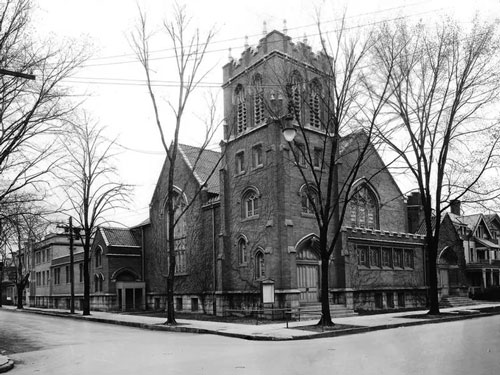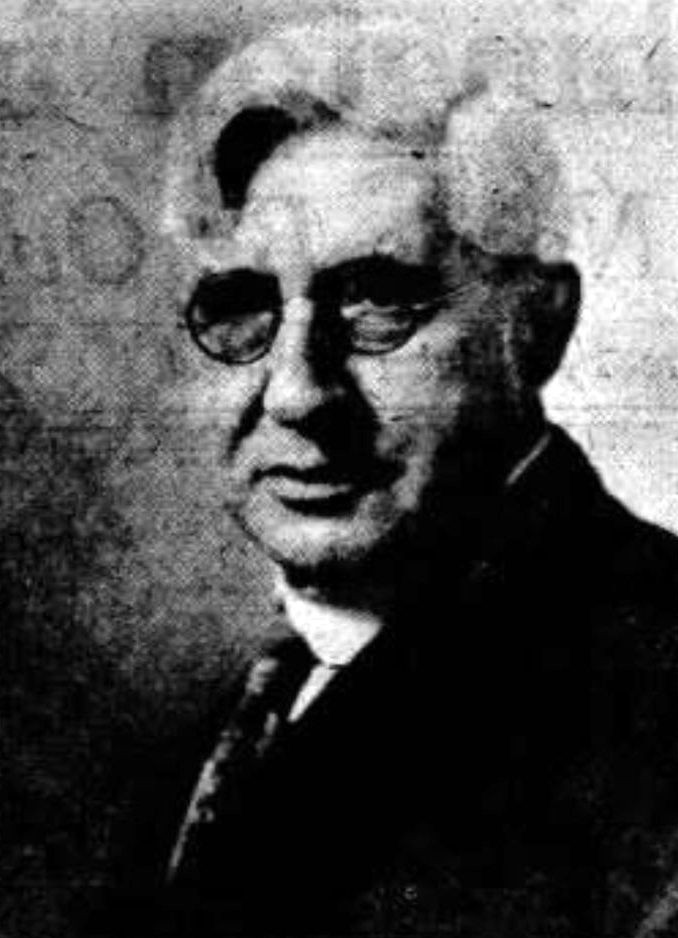Francis Everett Baldwin
Francis Everett Baldwin was born on August 31st, 1856, in Otego, Otsego County, New York. He was a son of John J. Baldwin and Sallie M. Baldwin, and one of 8 children (four boys and four girls) who survived to adulthood. His father was a blacksmith and would end up losing his property in the 1873 financial panic.
Francis Baldwin worked to afford his education. He attended common schools in Otego and the Academy at Oneonta. He supported his pursuit of higher education by teaching at district schools during the winter and doing farm work in the summer. He had joined the Methodist Episcopal Church at age 10, and by 21 had become a steward of the church. In 1877, Francis Baldwin moved to Elmira to study law with his brother Erwin. While studying law, he also taught night school at a local reformatory for two years. In 1881, he was admitted to practice law. He and his brother Erwin formed their own law firm, Baldwin and Baldwin, in Elmira.
In 1877, Francis Baldwin cast his first ballot. While he had been raised in a Republican family, he had chosen to side with the Prohibition Party and cast his vote for Prohibition Party candidates. In his first presidential election, he voted for Prohibition Party candidate Neal Dow. In 1916, Baldwin had stated that he had consistently voted for the Prohibition Party each election.
On May 7th, 1882, Baldwin married Anna E. Grandin. They would have two daughters: Lena (est. 1883) and Ethel (est. 1889). In the 1880’s, Francis Baldwin was significantly involved in Prohibition Party activism and rose through the ranks of the state party. In 1889, Baldwin became the state chairman of the Prohibition Party in New York, and would serve as chairman until 1893. On June 27th, 1894, the Prohibition Party held a statewide convention in Syracuse. The convention was attended by 600 delegates from around the state. It adopted a platform which included support for establishing statewide prohibition, condemning state laws licensing of alcohol institutions, and calling for recognition of the importance of the prohibition issue. It also included support for women’s suffrage, support for distributing the state legislative districts in proportion to population, opposition to the corruption of the major parties, support for reforms to combat bribery and election tampering, opposition to prostitution, opposition to gambling, support for a legal weekly day off for workers, support for separating local elections from state and federal elections, support for establishing postal savings bank to expand access to banks for more New Yorkers, support for having gold, silver, and paper currency as official legal tender, and support for a moderate approach to tariffs.
The convention nominated Francis Baldwin as its 1894 candidate for Governor, and Justus Miller (a well-off clothing manufacturer from Troy, New York) for Lieutenant Governor. Baldwin and the state party waged an active and enthusiastic campaign; with Baldwin speaking throughout the state. Baldwin received 23,525 (1.84%) votes, and came in 4th place. In 1897, Baldwin ran was the party’s candidate for Chief Judge of the New York State Court of Appeals. He received 19,643 (1.81%) votes and came in 4th place. In 1900, Baldwin became one of the New York representatives on Prohibition National Committee, and would hold the position until 1904.
In 1902, Baldwin left his career as a lawyer and became the head of a company that manufactured glass bottled. He was not only a fairly successful businessman, but did so while also refusing to sell his bottles to alcohol companies.
In 1906, Baldwin ran for congress in the 33rd district. He received 948 (2.45%) votes, and came in 3rd place. At the same, Baldwin remained active in the state party leadership. The 1906 New York State Prohibition handbook lists him as one of the members of the state’s executive committee. In 1910, Baldwin was the Prohibition Party candidate for state Attorney General. He received 23,767 (1.66%) votes and came in 5th place. In addition, being involved with the party statewide, Baldwin was also highly involved with the Prohibition Party in Chemung County. This included serving on the county executive committee, as well as running for local office. In 1911, Baldwin ran for mayor of the city of Elmira. He challenged the administration of incumbent Democratic mayor Daniel Sheehan. Baldwin ran on a platform which included support for making the city legally dry, and support for having the city establish municipal control of its waterworks. Baldwin received 229 votes (2.73%) votes, and came in 4th place. Mayor Sheehan was reelected to another term. But the Prohibition Party came away a victory in that election. There was a referendum on the ballot on city licensing of alcohol sales, and the majority of citizens voted that the city of Elmira would no longer grant licenses to sell alcohol in the city.
Baldwin also had a role to play in national Prohibition Party politics. He was a delegate at the 1912 Prohibition Party national convention, in Atlantic City. At the time, the national party faced a clash between different ideological sub factions over the selection of the party’s national chairman. The “Conservative” faction favored the retainment of incumbent chairman Charles Jones. While the “Insurgent” faction which favored the party’s national secretary W.G. Calderwood. Baldwin was a leading advocate for replacing Jones with a new chairman. Baldwin as successful at this effort, when the two factions agreed to a compromise candidate, and Virgil Hinshaw became the new national chairman.
In 1916, Baldwin once again became one of the New York committee members on the Prohibition National Committee. He would retain this position until 1924. At this time, Baldwin attracted national attention within the party. During the 1916 national convention, some members considered the possibility of nominating him for president. Though Baldwin himself declared that he would not seek the nomination, because he was busy with business and did not believe that he had the time to dedicate to a presidential campaign. There were also those who considered the possibility of nominating him during the 1920 national convention. But nothing came of it that time either. Though Baldwin didn’t pursue a run for the presidency, he continued to be active in the party. He helped plan the Chemung County Prohibition Party’s celebration of the passage of the 18th amendment. During national prohibition, he spoke in support of it and in favor of strong enforcement.
In 1922, Baldwin once again ran for state Attorney General. He received 23, 015 (0.95%) votes, and came in 4th pace.
Available sources don’t provide much information about Francis Baldwin after 1924. He continued by active in his community for several years. It’s not certain when he died, but it was sometime after 1932.
So, let’s conclude his story with how people described him when he lived. An 1894 article in the Elmira Star Gazette described him as such “Mr. Baldwin s possessed of a courteous and pleasant manner, which him a companionable and agreeable gentlemen to converse with. During his time Elmira he has on the esteem and respect of all classes of citizens and among his friends he classes those of all political, social, and religious sects.” In 1916, when fellow members of the party were talking him up as a possible presidential nominee, he portrayed himself with humility. In an interview he said, “My life has been short and unimportant” “but I have a passable reputation for honesty where I am not known”. Overall, Francis Baldwin had been a courteous and committed worker for the prohibition cause and for the Prohibition Party.
Sources: “A Victory This Year For Prohibition”. Star-Gazette (Elmira), October 30th, 1911. Accessed October 2th, 2018. https://www.newspapers.com/image/275799979/?terms=francis%2Bbaldwin%2Bprohibition Bain News Service, Publisher. Francis E. Baldwin. , ca. 1915. [Between and Ca. 1920] Photograph. https://www.loc.gov/item/2014702144/. "Baldwin, Francis E." Our Campaigns. Accessed October 25, 2018. https://www.ourcampaigns.com/CandidateDetail.html?CandidateID=19549. “Big Ratification Meeting”. Star-Gazette (Elmira), June 24, 1916. Accessed October 25th, 2018. https://www.familysearch.org/search/ark:/61903/1:1:MKMG-G64 “Democrats Sweep City and County by Big Vote: Control Common Council by 9 to 3; Supervisors 16 to 6”. Star-Gazette (Elmira), November 8, 1911. Accessed October 25th, 2018. https://www.newspapers.com/image/275794101/?terms=mayor “Elmiran One of Several Possible Candidates”. Star-Gazette (Elmira), July 3, 1894. Accessed October 25th, 2018. https://www.newspapers.com/image/276153442/?terms=francis%2Bbaldwin%2Bprohibition “Elmirans Very Prominent at Prohbition Convention: Frances E. Baldwin Conspicuous Figure in Atlantic City – Leads Fight Against Organization – Other Local Delegates There”. Star-Gazette (Elmira), July 13th, 1912. Accessed October 25, 2018. https://www.newspapers.com/image/275839921/?terms=francis%2Bbaldwin%2Bprohibition “For Prohibitions, State Convention – F. E. Baldwin of Elmira Named For Governor”. Star-Gazette (Elmira), June 27th, 1894. Accessed October 25, 2018. https://www.newspapers.com/image/275462654/?terms=francis%2Bbaldwin%2Bprohibition "Francis E Baldwin United States Census, 1900." FamilySearch. Accessed October 26, 2018. https://www.familysearch.org/search/ark:/61903/1:1:MS62-FMR "Francis E Baldwin United States Census, 1905." FamilySearch. Accessed October 26, 2018. https://www.familysearch.org/search/ark:/61903/1:1:MKMG-G64 "Francis E Baldwin United States Census, 1910." FamilySearch. Accessed October 26, 2018. https://www.familysearch.org/search/ark:/61903/1:1:M5Q3-VB3. "Francis E. Baldwin: Interview With The Prohibition Candidate For Governor." Star-Gazette (Elmira), June 30, 1894. Accessed October 25, 2018. https://www.newspapers.com/image/275462870/?terms=francis baldwin prohibition. Francis E. Baldwin Mentioned For President by Prohis”. Star-Gazette (Elmira), July 21st, 1920. Accessed October 25, 2018. https://www.newspapers.com/image/276087131/?terms=francis%2Bbaldwin%2Bprohibition Kestenbaum, Lawrence. "Index to Politicians: Baldwin." The Political Graveyard. Accessed October 25, 2018. http://politicalgraveyard.com/bio/baldwin.html. Makeley, Jonathan T. “Introduction” in Calderwood, W.G. Temperance Facts. (1940). Ed. Jonathan Makeley. Alfred, New York: Whitlock Publishing, 2017. Prohibition Party Hand-book, State of New York, 1906. Elmira, N.Y.: Chemung Print. Co, 1906. https://babel.hathitrust.org/cgi/pt?id=mdp.39015071647940;view=1up;seq=3 “Prohis Name City Ticket”. Star-Gazette (Elmira), September 13, 1913. Accessed October 25, 2018. https://www.newspapers.com/image/275774554/?terms=francis%2Bbaldwin%2Bprohibition Star-Gazette (Elmira), November 9, 1932. Page 8. Accessed October 25, 2018. https://www.newspapers.com/image/276649000/?terms=francis%2Bbaldwin%2Bprohibition To Hold Formal Obsequies For Late John Barleycorn”. Star-Gazette (Elmira), January 18, 1919. Accessed October 25, 2018. https://www.newspapers.com/image/276315277/?terms=francis%2Bbaldwin%2Bprohibition “Want Elmiran as Nominee For President of Nation”. Star-Gazette (Elmira), June 22, 1916. Accessed October 25, 2018.
-- Contributed by Jonathan Makeley
Hedding Methodist Episcopal Church

The Elmira Star Gazette, published an obituary for Baldwin saying that he had died on December 19th, 1930, from Pneumonia, during a family trip in Menton, France. The obituary provides some other details about Baldwin’s wife. and it states that Baldwin’s bottle company mainly produced milk bottles, also that he had got started in the bottle making business after hearing about a new bottle making machine that had been patented, that he was also involved in several dairy supply companies, and that his bottle manufacturing business at its height had several plants in New York, Pennsylvania, West Virginia, Virginia, and Illinois). He ran the company until 1927, when he sold it off and retired. He was involved in the Hedding Methodist Episcopal Church in Elmira. He had been a director of the Elmira chamber of commerce for 8 years, for a time he had been director of the Elmira Rotary club, and he had spent some time on the Elmira water board.
-- Additional information from Tim SanSoucie
[BACK]
